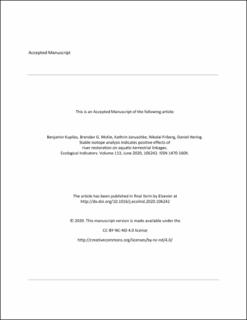| dc.contributor.author | Kupilas, Benjamin | |
| dc.contributor.author | McKie, Brendan G | |
| dc.contributor.author | Januschke, Kathrin | |
| dc.contributor.author | Friberg, Nikolai | |
| dc.contributor.author | Hering, Daniel | |
| dc.date.accessioned | 2021-06-01T09:27:41Z | |
| dc.date.available | 2021-06-01T09:27:41Z | |
| dc.date.created | 2020-09-06T22:45:36Z | |
| dc.date.issued | 2020 | |
| dc.identifier.citation | Ecological Indicators. 2020, 113, 106242. | en_US |
| dc.identifier.issn | 1470-160X | |
| dc.identifier.uri | https://hdl.handle.net/11250/2757176 | |
| dc.description | This is an accepted author's manuscript. Embargo until March 4 2022. | en_US |
| dc.description.abstract | Hydromorphological river restoration can significantly alter habitat configuration and modify invertebrate assemblages of rivers and floodplains. However, the consequences of these changes for ecosystem functioning and aquatic-terrestrial interactions are not known. As a restored shoreline has a more heterogeneous structure compared to a straightened river, restoration is likely to impact aquatic-terrestrial linkages in multiple ways, which might be captured based on biomarker indicators to characterize changes in food web functioning. We conducted a large scale comparative study targeting eleven river restoration projects in central and northern Europe to assess effects of river restoration on trophic patterns across the aquatic-terrestrial interface. We investigated the isotopic composition (δ13C, δ15N) of prey and of invertebrate consumers stratifying between the aquatic, riparian and terrestrial zones. The isotopic distance of riparian arthropods to instream macroinvertebrates and terrestrial arthropods was used as a measure of trophic linkage, and its variation with riparian habitat composition was quantified. Restoration enhanced aquatic-terrestrial linkages, indicated especially by differentiation in the δ15N isotopic signatures between aquatic, riparian and terrestrial consumers, rather than by δ13C signatures. The δ15N isotopic signatures of riparian arthropods revealed a higher relative trophic position in restored sections (δ15NRestored: 8.64‰, n = 11) as compared to non-restored sections (δ15NDegraded: 8.05‰, n = 11), lending support to the conjecture that restoration increased the proportion of more highly enriched aquatic prey (δ15NRestored: 10.01‰; δ15NDegraded: 10.38‰) while simultaneously reducing the share of lower enriched terrestrial prey (δ15NRestored: 4.88‰; δ15NDegraded: 5.53‰). Riparian habitat diversity and the share of exposed sand and gravel bars were positively related to the strength of aquatic-terrestrial linkages (R2 = 0.28 and R2 = 0.31, respectively), pointing to the importance of habitat diversification in the riparian zone in promoting trophic linkages between river and floodplain. These findings expand our understanding of the multifaceted outcomes of hydromorphological restoration, beyond biodiversity in the aquatic environment. It highlights the need to expand our current set of indicators in order to mechanistic understand restoration effects on ecological networks spanning across boundaries. This knowledge is highly relevant for the large restoration efforts driven by legislative frameworks such as the Water Framework Directive in Europe. | en_US |
| dc.language.iso | eng | en_US |
| dc.publisher | Elsevier | en_US |
| dc.rights | Attribution-NonCommercial-NoDerivatives 4.0 Internasjonal | * |
| dc.rights.uri | http://creativecommons.org/licenses/by-nc-nd/4.0/deed.no | * |
| dc.title | Stable isotope analysis indicates positive effects of river restoration on aquatic-terrestrial linkages | en_US |
| dc.type | Peer reviewed | en_US |
| dc.type | Journal article | en_US |
| dc.description.version | acceptedVersion | en_US |
| dc.rights.holder | © 2020 | en_US |
| dc.source.pagenumber | 9 | en_US |
| dc.source.volume | 113 | en_US |
| dc.source.journal | Ecological Indicators | en_US |
| dc.identifier.doi | 10.1016/j.ecolind.2020.106242 | |
| dc.identifier.cristin | 1827599 | |
| dc.relation.project | Norges forskningsråd: 264499 | en_US |
| dc.relation.project | EC/FP7/282656 | en_US |
| dc.source.articlenumber | 106242 | en_US |
| cristin.ispublished | true | |
| cristin.fulltext | postprint | |
| cristin.qualitycode | 1 | |

